New Scots refugee integration strategy 2018 to 2022: engagement analysis
Analysis of engagement which informed the development of Scotland’s second New Scots refugee integration strategy.
Chapter 2 Profile of responses
This chapter sets out an analysis of those who participated in the engagement. Alongside the main engagement questions, respondents were asked to provide the location and date of their event, as well as information about the demographic make-up of participants. This included the presence of participants with protected characteristics, the types of services present, total number of participants, and the name of the event's host organisation. This chapter is an analysis of this information.
2.1 Total participation and events
A total of 94 sources were included in the engagement analysis. The majority of sources were responses which captured discussion during one-off engagement events. However, some chose to hold more than one event, while others chose to supplement their answers with previous research and surveys. Of the total of the 94 sources considered in this analysis:
- Six were "organisational responses", meaning no event was held, and no participation figures were available. This includes a non-standard organisational response that did not answer the questions.
- One response was from an individual who had carried out interviews with refugees and asylum seekers over the phone.
- Seven responses were based on two engagement events.
- 80 responses were based on a single engagement event; this includes the 2016 conference.
At least 701 refugees and asylum seekers were present during engagement events. The actual number is likely to be significantly higher since numerous responses did not specify the exact number of refugees and/or asylum seekers present during these events.
The total number of participants recorded was 2,046. The actual figure is also likely to be higher as six responses did not provide information about the number of contributors.
The average number of people participating in the engagement events was 22 [3] , but the number of participants per event varied considerably, ranging from 1 to 170 people. However, 30% of responses reported between 1 and 10 participants contributing overall, another 34%, between 11 and 20 participants [4] . Three responses reported over 100 participants at their events [5] .
Figure 1 – The number of participants represented per response
2.2 Geographical distribution of events
Figure 2 overleaf shows that responses were clustered around the central belt of Scotland, particularly around Glasgow and Edinburgh. This reflects the clustering of services relating to refugees and asylum seekers in these areas, and the size of the refugee and asylum seeker populations in the central belt. However, a number of responses did come from outwith this region, including in Perth, Dundee, Aberdeen and Inverness.
The number of participants contributing to a response did not appear to follow any particular pattern, with differently sized events and responses distributed across Scotland. One of the largest engagment events was hosted by the Scottish Refugee Council in Inverurie, outwith the central belt.
Figure 2 - Map of Scotland displaying the distribution of responses, colour coded by size band of participants contributing [Source: Rocket Science analysis of Scottish Government data and use of Google Fusion tables]
![Figure 2 - Map of Scotland displaying the distribution of responses, colour coded by size band of participants contributing [Source: Rocket Science analysis of Scottish Government data and use of Google Fusion tables] Figure 2 - Map of Scotland displaying the distribution of responses, colour coded by size band of participants contributing [Source: Rocket Science analysis of Scottish Government data and use of Google Fusion tables]](/binaries/content/gallery/publications/research-publication/2018/06/news-scots-2-engagement-analysis-new-scots-refugee-integration-strategy/00537022.jpg)
2.3 Event period
Engagement events took place during the engagement period outlined by the Scottish Government (June to September 2017), with over 80% hosted in August or September 2017. Events shown outwith this period were either pilot engagement events/responses, or correspond to the initial conference in December 2016.
Figure 3 – The timing during which the events took place
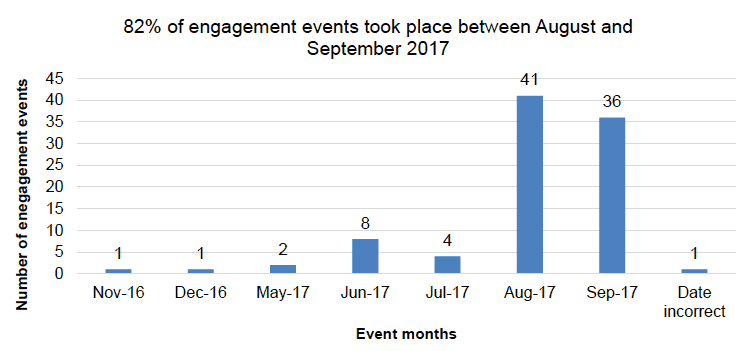
2.4 Demographic profile of events and types of service present
Most responses specified who were at each event against a range of different categories. Almost all events had people with a number of different characteristics present, and included variations in age, gender and profession. This allows a description of the profile of people contributing to responses, but it is not possible to provide precise numbers of particular groups, as this was not provided consistently across responses.
Refugees and/or asylum seekers contributed to more than two thirds of responses (72%), with refugees or people with another form of humanitarian protection status [6] (68%) contributing more often than asylum seekers, who contributed to just over a third of responses (36%) (see Figure 4 below).
Figure 4 – The number and percentage of responses involving refugees or persons with a protection status, and persons seeking asylum [7]
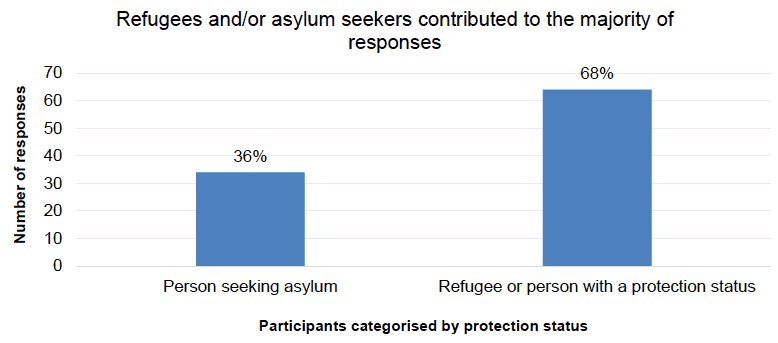
It was common for responses to include people of different ages and genders. Some engagement events/responses had a specific focus, such as young people or women, but most had a mixture of contributing voices.
Figure 5 – The percentage of responses where particular genders and age groups contributed [8]
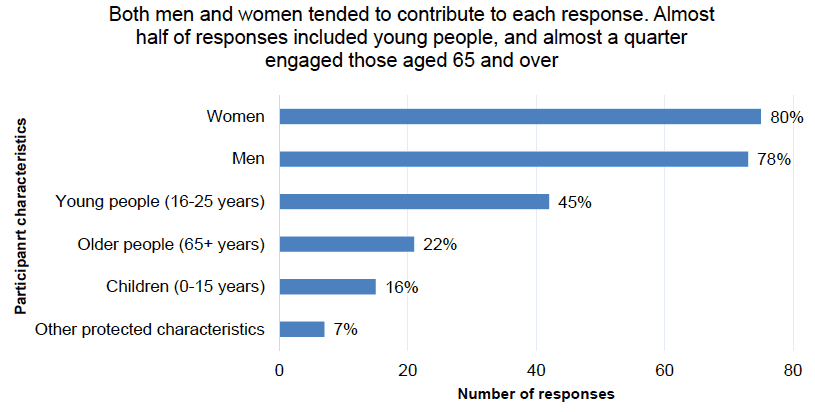
The majority of responses had representatives from a number of different professional sectors contributing. The third sector was well represented, with 40% of responses including a charity employee or volunteer, and 24% stating that members of a voluntary group contributed. Almost a third of responses (31%) included members of the host community (members of the public who are not refugees or asylum seekers). Local authority representatives contributed to around a quarter of all responses (24%), and other public sector representatives contributed to 20%. 18% of people were classified as "Other", including organisational responses and academics.
Figure 6 – The percentage of events at which members of particular groups were present
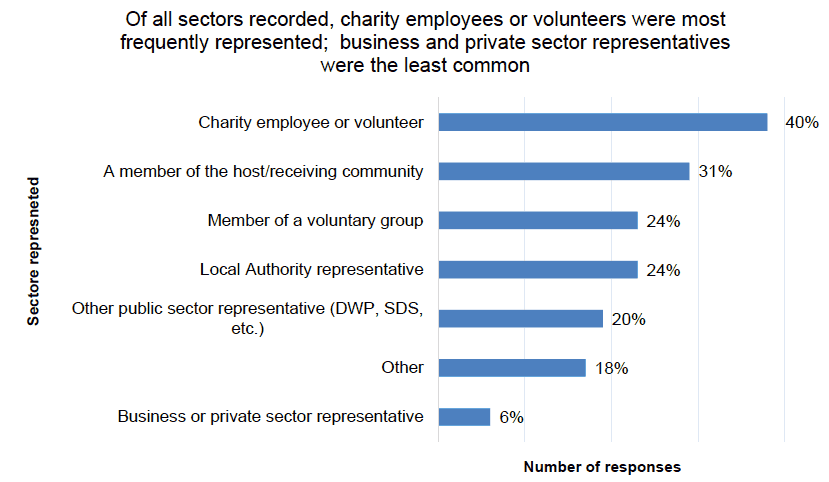
People representing organisations were asked to specify whether they currently worked directly with refugees, planned or coordinated services for refugees, or did not work with refugees yet. Nearly half of responses (47%) engaged at least one member of a frontline service working with refugees, and just over a third of responses (34%) included someone from a service that planned/coordinated refugee services. 7% of responses had services contributing that were not yet involved in working with refugees.
Figure 7 – The types of services present at events
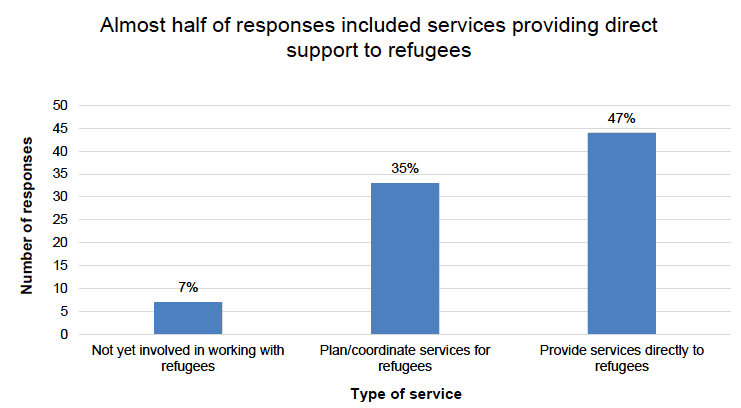
2.5 Overview of prevalence of the different New Scots themes among responses
Figure 8 provides an overview of the proportion of responses that commented on the different New Scot themes (ie issues that fall under the different New Scots themes) and the theme of poverty and destitution.
Figure 8 – The proportion of responses commenting on different themes
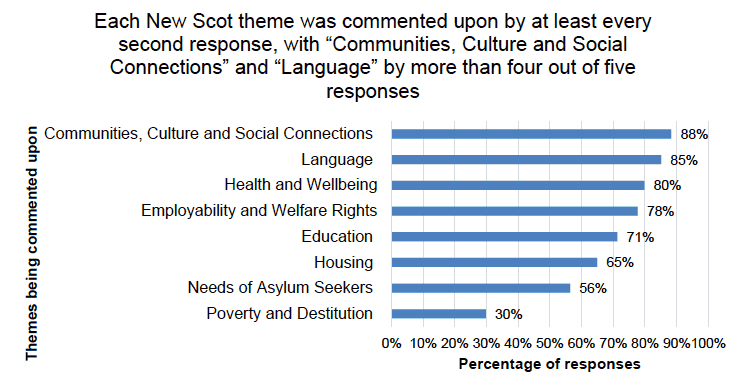
Although the engagement did not ask specifically about the different New Scots themes, each New Scots theme was commented upon by at least every second response. This shows that the seven New Scots themes capture what is important to refugees and asylum seekers in Scotland.
The New Scots theme commented upon most often was Communities, Culture and Social Connections, with 88% of responses commenting on it. Three other New Scots themes were commented upon by a large majority of repsonses: Language (85%), Health and Wellbeing (80%) and Employability and Welfare Rights (78%).
The New Scots theme commented upon least often was Needs of Asylum Seekers, yet still more than half (56% of responses) raised points in relation to this. While this theme covers issues that affect asylum seekers only, all the other themes cover issues that affect both refugees and asylum seekers. As such, the slightly lower proportion of responses commenting specifically on the Needs of Asylum Seekers as compared to the other themes does not mean that responses considered the needs of asylum seekers to be less important than the other New Scots themes. Instead, it is likely to be a reflection of this theme focusing on a particular group (ie asylum seekers) as opposed to a particular issue (eg housing).
Many responses raised points in relation refugees and asylum seekers' experience of poverty and destitution.
Contact
There is a problem
Thanks for your feedback